Circular Economy on Construction and Demolition Waste: A Literature Review on Material Recovery and Production
Abstract
1. Introduction
2. Methodology
- Studies that assess and discuss the use of recovered materials in the manufacturing of new construction materials from a CE perspective.
- Studies that assess reuse, recycling, and recovery of CDW from an environmental perspective.
- Studies that assess and discuss the effectivity of recovered, reused, or recycled CDW from a mechanical/performance perspective.
- Studies that discuss effective CE framework in CDW material recovery and production.
- Topic 1: demolition, waste, material, recycling
- Topic 2: circular economy, construction, environment, transition
- Topic 3: research, potential, reuse, building
- Topic 4: aggregate, concrete, strength, mechanical
3. CE Framework on Material Recovery and Production
- Narrowing resource loops—use of less material input for production in order to have less waste output at the end of life.
- Slowing loops—this means the lengthening of the use phase of materials.
- Closing resource loops—this can also be equal to the process of recycling of materials.
4. CDW Material Reuse and Recycling in CE
- Adaptive reuse—is a method that reuses whole or part of a structure that is redundant.
- Deconstruction—is the careful dismantling to maximize the recovery of components to be reused.
- Design for deconstruction (DfD)—is a designing method that closes construction component loops.
- Design for reuse (DfR)—incorporates the use of reclaimed components in the design of new structures.
5. Research Gaps and Emerging Topics
6. Conclusions and Recommendation
Author Contributions
Funding
Conflicts of Interest
References
- Arenas, C.; Galiano, Y.; Leiva, C.; Vilches, L.F.; Arroyo, F.; Villegas, R.; Pereira, C. Development of a fly ash-based geopolymeric concrete with construction and demolition wastes as aggregates in acoustic barriers. Constr. Build. Mater. 2017, 134, 433–442. [Google Scholar] [CrossRef]
- Huang, B.; Wang, X.; Kua, H.; Geng, Y.; Bleischwitz, R. Construction and demolition waste management in China through the 3R principle. Resour. Conserv. Recycl. 2018, 129, 36–44. [Google Scholar] [CrossRef]
- Silva, R.V.; de Brito, J.; Dhir, R.K. Availability and processing of recycled aggregates within the construction and demolition supply chain: A review. J. Clean. Prod. 2017, 143, 598–614. [Google Scholar] [CrossRef]
- Akhtar, A.; Sarmah, A.K. Construction and demolition waste generation and properties of recycled aggregate concrete: A global perspective. J. Clean. Prod. 2018, 186, 262–281. [Google Scholar] [CrossRef]
- Cullham, W.B. Construction and demolition debris need special care. Solid Wastes Manag. 1975, 18, 50–52. [Google Scholar]
- Ruiz, L.; Ramón, X.; Domingo, S. The circular economy in the construction and demolition waste sector—A review and an integrative model approach. J. Clean. Prod. 2020, 248, 119238. [Google Scholar] [CrossRef]
- Kirchherr, J.; Reike, D.; Hekkert, M. Conceptualizing the circular economy: An analysis of 114 definitions. Resour. Conserv. Recycl. 2017, 127, 221–232. [Google Scholar] [CrossRef]
- Luttenberger, L. Waste management challenges in transition to circular economy—Case of Croatia. J. Clean. Prod. 2020, 256, 120495. [Google Scholar] [CrossRef]
- Ghisellini, P.; Ripa, M.; Ulgiati, S. Exploring environmental and economic costs and benefits of a circular economy approach to the construction and demolition sector: A literature review. J. Clean. Prod. 2018, 178, 618–643. [Google Scholar] [CrossRef]
- Roque, C.; Cardoso, J.; Connell, T.; Schermers, G.; Weber, R. Topic analysis of road safety inspections using latent Dirichlet allocation: A case study of roadside safety in Irish main roads. Accid. Anal. Prev. 2019, 131, 336–349. [Google Scholar] [CrossRef]
- Nußholz, J.; Rasmussen, F.; Whalen, K.; Plepys, A. A circular business model for material reuse in buildings: Implications on value creation. J. Clean. Prod. 2020, 245, 118546. [Google Scholar] [CrossRef]
- Ghaffar, S.; Burman, M.; Braimah, N. Pathways to circular construction: An integrated management of construction and demolition waste for resource recovery. J. Clean. Prod. 2020, 244, 118710. [Google Scholar] [CrossRef]
- Baldassarre, B.; Schepers, M.; Bocken, N.; Cuppen, E.; Krevaar, G.; Calabretta, G. Industrial symbiosis: Towards a design process for eco-industrial clusters by integrating circular economy and industrial ecology perspectives. J. Clean. Prod. 2019, 216, 446–460. [Google Scholar] [CrossRef]
- Yu, B.; Wang, J.; Li, J.; Lu, W.; Li, C.; Xu, X. Quantifying the potential of recycling demolition waste generated from urban renewal: A case study in Shenzhen, China. J. Clean. Prod. 2020, 247, 119–127. [Google Scholar] [CrossRef]
- Bocken, N.; Pauw, I.; Bakker, C.; Grinten, B. Product design and business model strategies for a circular economy. J. Ind. Prod. Eng. 2016, 33, 308–320. [Google Scholar] [CrossRef]
- Sluymers, J.J. Reuse of waste from construction and demolition. Noodzaak 1979, 28, 214–217. [Google Scholar]
- Pun, S.; Liu, C. A framework for material management in the building demolition industry. Archit. Sci. Rev. 2006, 49, 391–398. [Google Scholar] [CrossRef]
- Rao, A.; Jha, K.N.; Misra, S. A framework on the use of construction and demolition waste as recycled aggregate in India. Indian Concr. J. 2006, 80, 12–19. [Google Scholar]
- Rios, F.; Grau, D.; Chong, W. Reusing exterior wall framing systems: A cradle-to-cradle comparative life cycle assessment. Waste Manag. 2019, 94, 120–135. [Google Scholar] [CrossRef]
- Zhang, L.; Sojobi, A.; Kodur, V.; Liew, K. Effective utilization and recycling of mixed recycled aggregates for a greener environment. J. Clean. Prod. 2019, 236, 117600. [Google Scholar] [CrossRef]
- Iacovidou, E.; Purnell, P. Mining the physical infrastructure: Opportunities, barriers, and interventions in promoting structural component reuse. Sci. Total Environ. 2016, 557–558, 791–807. [Google Scholar] [CrossRef]
- Choudhary, J.; Kumar, B.; Gupta, A. Utilization of solid waste materials as alternative fillers in asphalt mixes: A review. Constr. Build. Mater. 2020, 234, 117271–117289. [Google Scholar] [CrossRef]
- Mendoza, F.; Altabella, J.; Izquierdo, A. Application of inert wastes in the construction, operation and closure of landfills: Calculation tool. Waste Manag. 2016, 59, 276–285. [Google Scholar] [CrossRef] [PubMed]
- Chen, W.; Jin, R.; Xu, Y.; Wanatowski, D.; Li, B.; Yan, L.; Pan, Z.; Yang, Y. Adopting recycled aggregates as sustainable construction materials: A review of the scientific literature. Constr. Build. Mater. 2019, 218, 483–496. [Google Scholar] [CrossRef]
- Smol, M.; Kulczycka, J.; Henclik, A.; Gorazda, K.; Wzorek, Z. The possible use of sewage sludge ash (SSA) in the construction industry as a way towards a circular economy. J. Clean. Prod. 2014, 95, 45–54. [Google Scholar] [CrossRef]
- del Bosque, I.S.; Van den Heede, P.; De Belie, N.; de Rojas, M.S.; Medina, C. Carbonation of concrete with construction and demolition based recycled aggregates and cement with recycled content. Constr. Build. Mater. 2020, 234, 117336–117352. [Google Scholar] [CrossRef]
- Valdes, A.; Robles, D.; Gonzalez, J.; Romero, M.; Pozo, J. Mechanical and microstructural characterization of non-structural precast concrete made with recycled mixed ceramic aggregates from construction and demolition waste. J. Clean. Prod. 2018, 180, 482–493. [Google Scholar] [CrossRef]
- Merino, M.; Saez, P.; Longobardi, I.; Astorqui, J.; Porras-Amores, C. Redesigning lightweight gypsum with mixes of polysterene waste from construction and demolition waste. J. Clean. Prod. 2019, 220, 144–151. [Google Scholar] [CrossRef]
- Zhao, Z.; Courard, L.; Groslambert, S.; Jehin, T.; Leonard, A.; Xiao, J. Use of recycled concrete aggregates from precast block for the production of new building blocks: An insdustrial scale study. Resour. Conserv. Recycl. 2020, 157, 104786. [Google Scholar] [CrossRef]
- Merli, R.; Preziosi, M.; Acampora, A.; Lucchetti, M.; Petrucci, E. Recycled fibers in reinforced concrete: A systematic literature review. J. Clean. Prod. 2020, 248, 119207. [Google Scholar] [CrossRef]
- Morales, M.; Moyano, G.; Espinosa, I.; Palacios, I. Effect of recycled aggregate on physical-mechanical properties and durability of vibro-compacted dry-mixed concrete hollow blocks. Constr. Build. Mater. 2017, 145, 303–310. [Google Scholar] [CrossRef]
- Arrigoni, A.; Beckett, C.; Ciancio, D.; Pelosato, R.; Dotelli, G.; Grillet, A. Rammed earth incorporating recycled concrete aggregate: A sustainable, resistant and breathable construction solution. Resour. Conserv. Recycl. 2018, 137, 11–20. [Google Scholar] [CrossRef]
- Cantero, B.; Saez del Bosque, I.F.; Matias, A.; Medina, C. Statistically significant effects of mixed recycled aggregate on the physical-mechanical properties of structural concretes. Constr. Build. Mater. 2018, 185, 93–101. [Google Scholar] [CrossRef]
- Ruiperez, C.; Rodriguez, A.; Gonzales, S.; Calderon, V. Lightweight masonry mortars made with expanded clay and recycled aggregates. Constr. Build. Mater. 2016, 118, 139–145. [Google Scholar] [CrossRef]
- Manzi, S.; Mazzotti, C.; Bignozzi, M.C. Self-compacting concrete with recycled aggregate: Study of the long-term properties. Constr. Build. Mater. 2017, 157, 582–590. [Google Scholar] [CrossRef]
- Fiol, F.; Thomas, C.; Munoz, C.; Lopez, V.; Manso, J.M. The influence of recycled aggregates from precast elements on the mechanical properties of structural self-compacting concrete. Constr. Build. Mater. 2018, 182, 309–323. [Google Scholar] [CrossRef]
- Kazemian, F.; Rooholamini, H.; Hassani, A. Mechanical and fracture properties of concrete containing treated and untreated recycled concrete aggregates. Constr. Build. Mater. 2019, 209, 690–700. [Google Scholar] [CrossRef]
- Fraj, A.; Idir, R. Concrete based on recycled aggregates—Recycling and environmental analysis: A case study of paris’ region. Constr. Build. Mater. 2017, 157, 952–964. [Google Scholar] [CrossRef]
- Topini, D.; Toraldo, E.; Andena, L.; Mariani, E. Use of recycled fillers in bituminous mixtures for road pavements. Constr. Build. Mater. 2018, 159, 189–197. [Google Scholar] [CrossRef]
- Pasetto, M. The re-utilization of discarded building materials in cement-stabilized layers of road and airfield pavements. Waste Materials in Construction. 2000, 548–566. [Google Scholar] [CrossRef]
- Gayarre, F.; Gonzalez, J.; Vinuela, R.; Perez, C.; Lopez, M.A. Use of recycled mixed aggregates in floor blocks manufacturing. J. Cleanf. Prod. 2017, 167, 713–722. [Google Scholar] [CrossRef]
- Wichrowska, K.; Pawluczuk, E.; Bołtryk, M. Waste-free technology for recycling concrete rubble. Constr. Build. Mater. 2018, 234, 117407. [Google Scholar] [CrossRef]
- Silva, R.V.; de Brito, J.; Dhir, R.K. Use of recycled aggregates arising from construction and demolition waste in new construction applications. J. Clean. Prod. 2019, 236, 117629. [Google Scholar] [CrossRef]
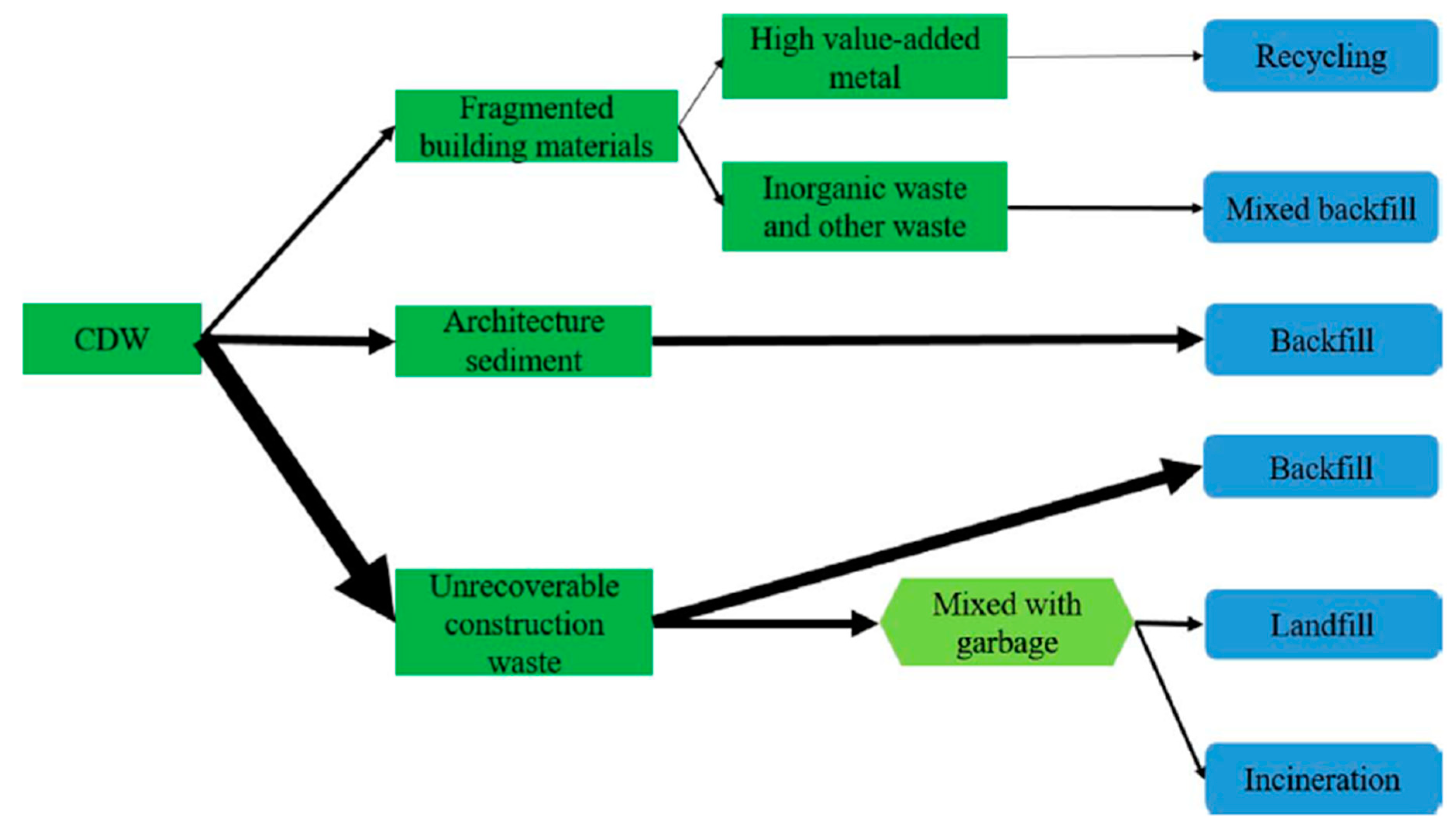
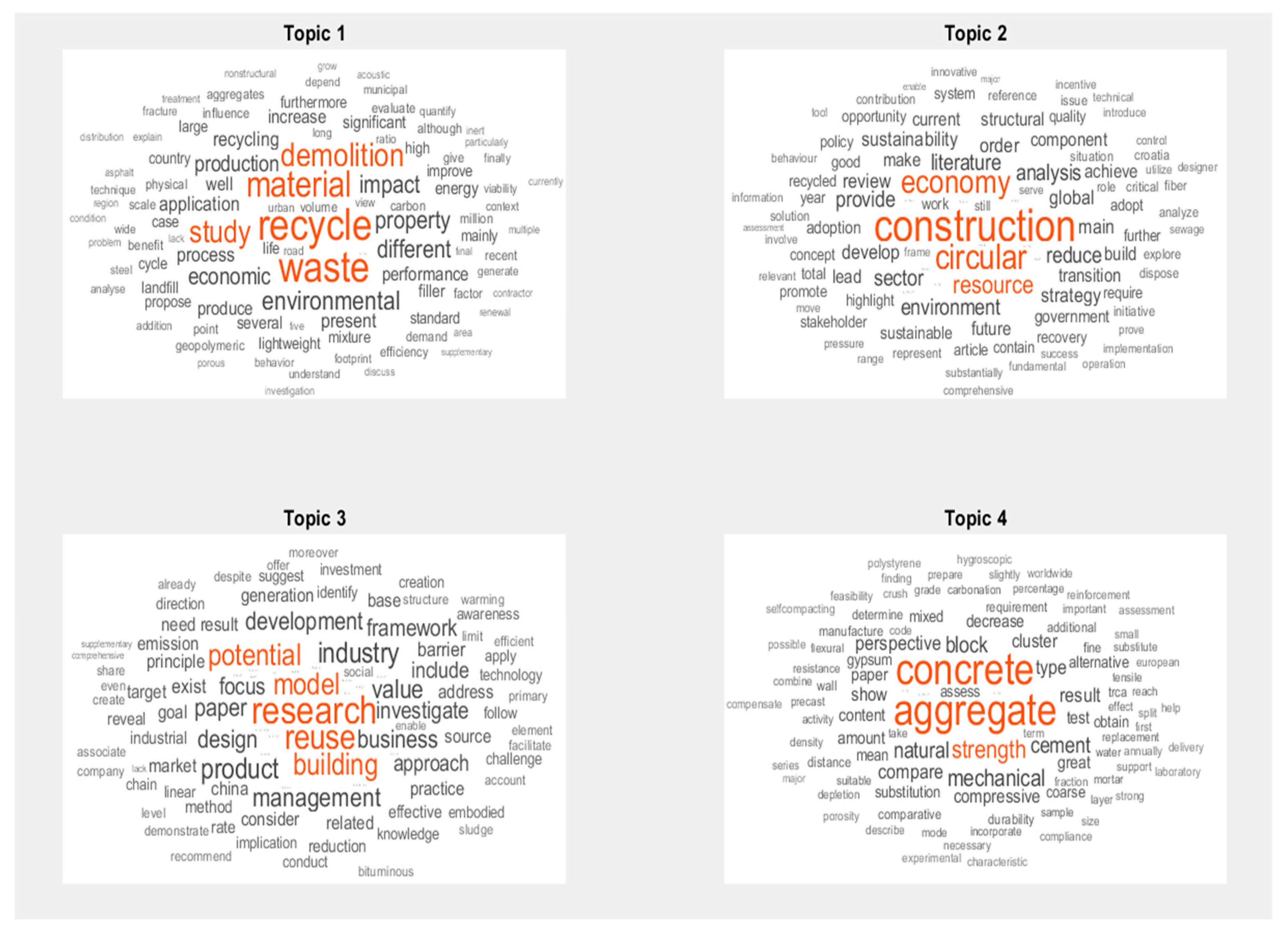

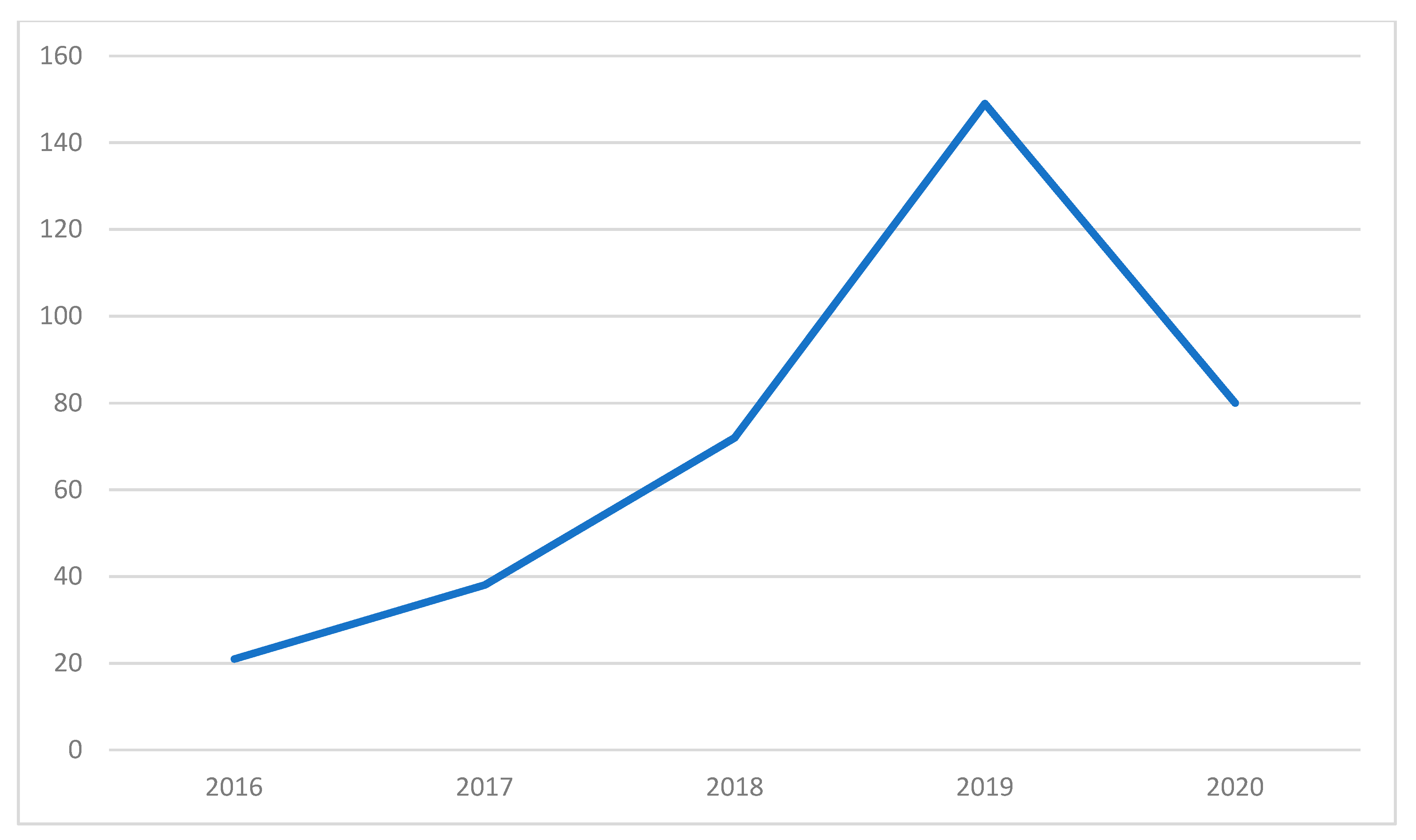

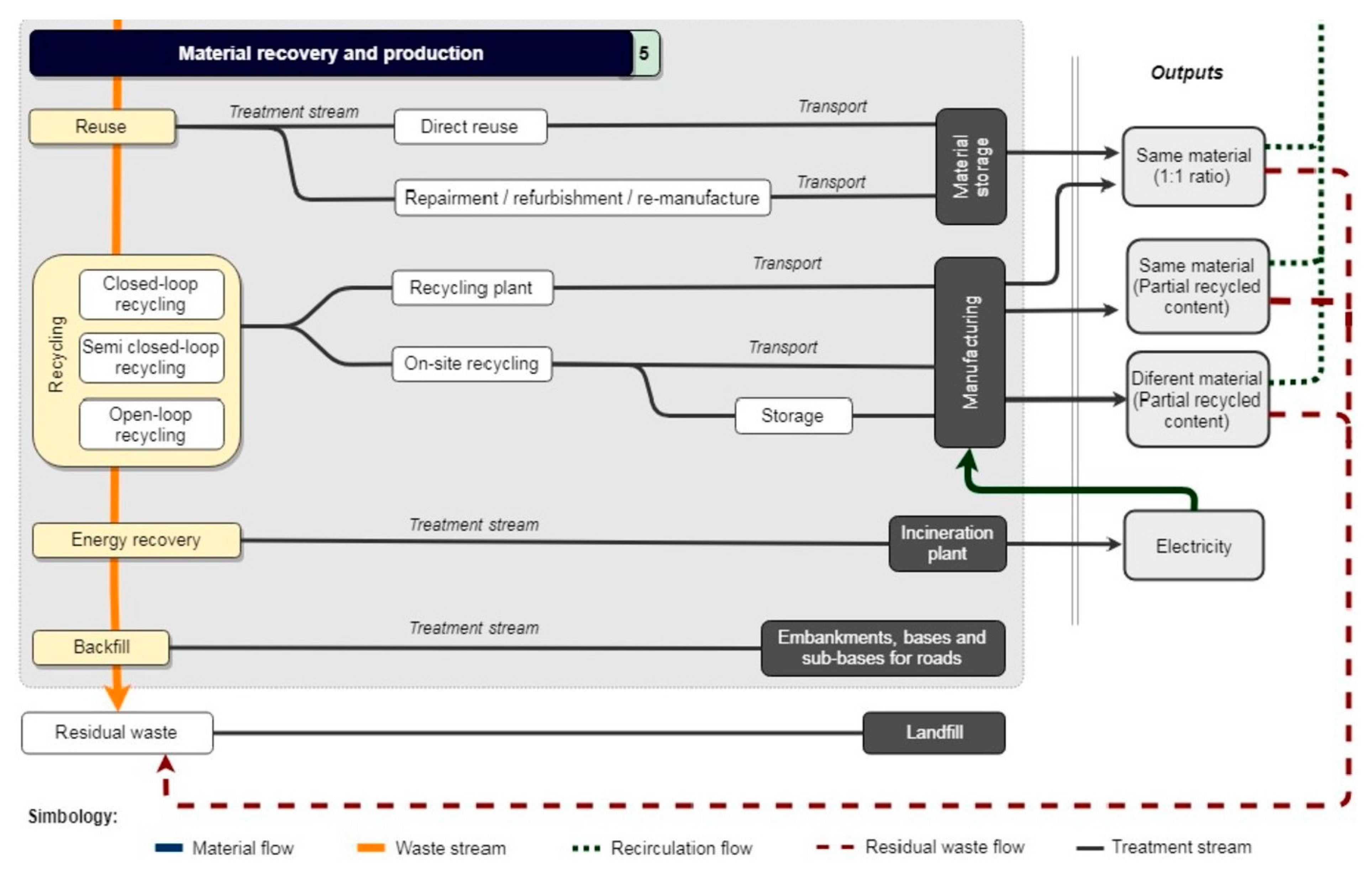
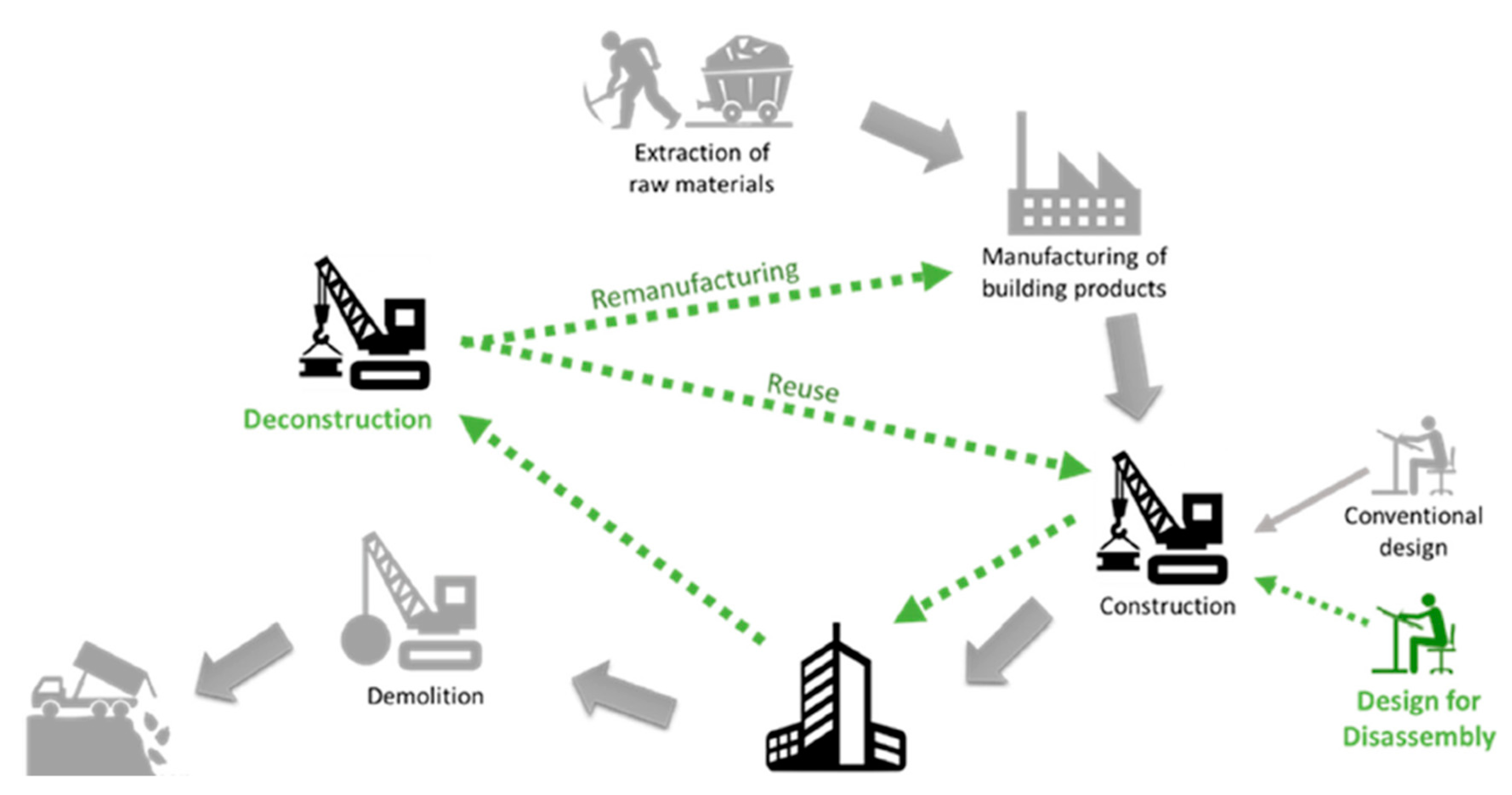

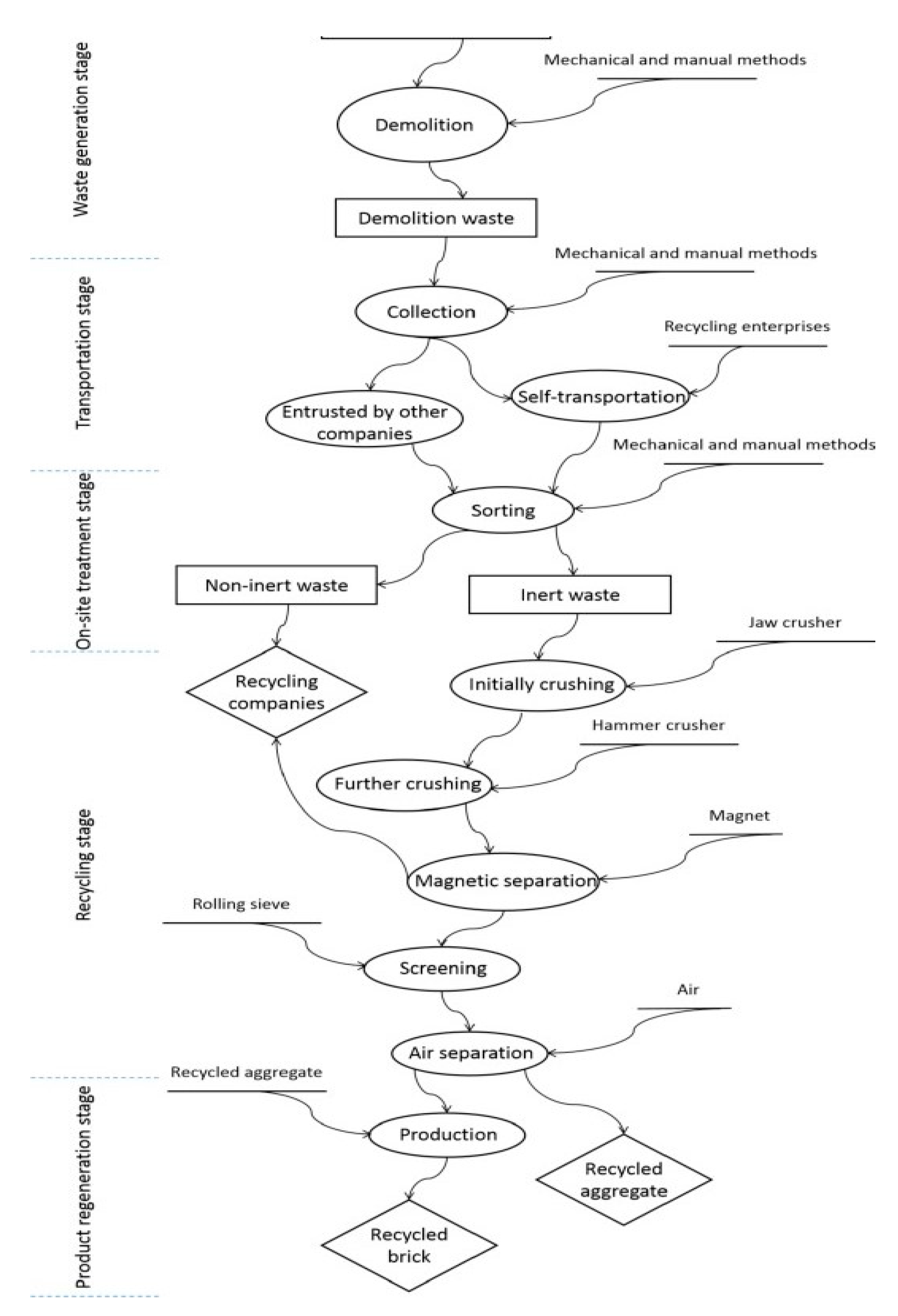

| Reference | Location | Year | Reuse | Recycling | Type | Observations |
|---|---|---|---|---|---|---|
| [22] | India | 2019 | * | Brick dust and Concrete dust | Mechanical properties of resulting asphalt achieved equal or greater amounts. | |
| [19] | U.S. | 2019 | * | Exterior wall frame systems | Reuse of exterior wall framing systems is feasible as long as transport distance is less than 3000 km. | |
| [1] | Spain | 2016 | * | RCA | Physical, mechanical, and acoustic properties were the same as control material. | |
| [25] | Poland | 2016 | * | Sewage sludge ash | Material can be used as substitute in various construction materials production. | |
| [26] | Spain | 2019 | * | RA | Replacing 25 wt. % with recycled aggregate induces no significant effect. | |
| [27] | Spain | 2018 | * | Ceramic aggregates | Material can be used in nonstructural functions. | |
| [28] | Spain | 2019 | * | Polystyrene from C&D | Expanded polyterene and extruded polysterene waste from construction and demolition can substitute currently used aggregates perlite and vermiculite. | |
| [29] | China | 2020 | * | RCA | Compressive strength of concrete blocks made with 100% RCA is within code requirements. | |
| [20] | China | 2019 | * | RCA | Recycling of CDW is economically feasible. | |
| [30] | Italy | 2019 | * | Concrete fibers | Recycled plastics and metal fibers in reinforced concrete can be used. | |
| [24] | China | 2019 | * | RA | Current research focuses on adopting recycled aggregates in new concrete production. | |
| [31] | Spain | 2017 | * | RA | In the production of nonstructural dry-mixed concrete hollow blocks, proper behavior was shown. | |
| [23] | Spain | 2016 | * | CDW | Recycling CDW can be attractive when the recycled product is competitive with the virgin material in terms of cost and quality. | |
| [32] | Italy | 2018 | * | RA | Using RCA into stabilized rammed earth material can be utilized. | |
| [33] | Spain | 2018 | * | RA | Concrete workability was not affected by use of 100% mixed recycled aggregate. Neither compressive nor flexural strength varied significantly at replacement ratios. | |
| [34] | Spain | 2016 | * | RA | Use of RA in production of lightweight mortars is a viable alternative. | |
| [35] | Italy | 2017 | * | RCA | Production of self-compacting concrete with coarse and fine RCA up to 40% in volume. | |
| [36] | Spain | 2018 | * | RCA | RCA from precast elements shows mechanical properties are slightly lower. | |
| [37] | Iran | 2019 | * | RCA | Slight decrease in flexural strength can be observed. | |
| [38] | France | 2017 | * | RA | 16% additional cement was needed to compensate the drop in compressive strength of RAC. | |
| [39] | Italy | 2017 | * | Fillers | Physical properties and mechanical performances are similar or even better compared to standard mixes. | |
| [40] | Italy | 2000 | * | RA | Strict relationship between mix design is important and dosages correlate to the strength of the resulting material. | |
| [41] | Spain | 2017 | * | RA | Substitution percentage below 35% show small decrease in mechanical properties. | |
| [11] | Sweden | 2019 | * | Concrete, Wood, Glass | Material reuse has potential to become a price-competitive production practice. | |
| [21] | U.K. | 2016 | * | Various construction and demolition materials | Reuse potential rates of commonly used construction materials has been established. | |
| [42] | Poland | 2018 | * | Concrete rubble | By using a patented technology on thermal and mechanical treatment, waste-free recycling of rubble concrete into valuable materials such as RA and RCM were obtained. |
| Location | Year | Type | RL | Observations |
|---|---|---|---|---|
| Finland | 1998 | RCA | 100% | Self-cementitious properties of RCA led to an increasing load-bearing capacity. |
| Portugal | 2009 | RCA | 100% | FWD test showed RCA layers have higher elastic moduli than the min. expected. |
| Singapore | 2008 | RCA | 100% | The IRI sections was similar to or even better than the control sections. |
| Netherlands | 1992 | RMA | 100% | Less strict requirements for alternative materials for mound dams are obtained due to successful experiences. |
| UK | 2004 | RCA/RAP | 4%/29% | Savings of almost 2 million GBP. |
| Singapore | 2008 | RCA | 100% | Similar IRI values were observed while the deflection was lower. |
| Spain | 2009 | MRA | 100% | Higher water content for optimum compaction was required but appropriate mechanical performance and low deflections under impact was found. |
| Spain | 2008 | RCA | 100% | Enhanced mechanical performance and similar to that expected of cement-treated gravel. |
| UK | 2007 | Tunnel spoil | 100% | Decreased number of lorry movements by around 400 thousand and savings of about 10 million GBP |
| UK | 1998 | RCA | 100% | FWD data showed the target elastic modulus of 2.5 GPa for combined bound layers. |
| UK | 2004 | RAP | 35% | Use of alternative materials offered a savings of 0.5 GBP/sq. meter. |
| UK | 2004 | RAP | 10% | Avoided the purchase of an equivalent to 54,000 tons of RAP and corresponding transportation cost. |
| UK | 2003 | RGA | 100% | Indirect financial benefits included the removal of materials out of the waste stream. |
| Canada | 2007 | RCA | 50% | Similar performance observed for all test sections suggesting no negative impact on the pavement’s performance. |
| USA | 2016 | RCA | 40% | Compressive strength and shrinkage were higher and lower by 25% and 12% compared to control. |
| USA | 1995 | RCA | 100% | Little difference in terms of performance |
| Austria | 1991 | RCA | 100% | The subbase was 5% cheaper than the traditional alternative. |
| UK | 2003 | RCA | 100% | The project showed that RCA concrete is suitable for use in an XF4 environment. |
| Spain | 2014 | MRA | 100% | 100% coarse MRA caused a decrease in strength but the difference between the two shortened in time. |
| Hong Kong | 2006 | RCA | 100% | Using 100% with added 4% of cement resulted in comparable compressive strength. |
| Germany | 1999 | RCA/MRA | 100% | Special decorative effects were achieved. |
| Germany | 2000 | MRA | 30% | No significant differences found. |
| UK | 1996 | RCA | 100% | 100% coarse aggregate needed 10% cement content increase to achieve adequate performance. |
| UK | 1996 | MRA | 20% | Similar strength development from conventional concrete was found. |
| Singapore | 2010 | RCA | 100% | Yielded equivalent mechanical and durability performance to that of control concrete. |
| Denmark | 1993 | RCA | N/A | About 275 cubic meters of RAC made with coarse RA were used. Considerable experience was gained in the use of RAC. |
| Germany | 2014 | RCA | 100% | The designed slump and target strength were achieved. |
| Germany | N/A | RCA | 35% | About 500 cubic meters of concrete with 35% of coarse RCA were used. |
| Reuse Potential Rates of a Range of Construction Components | |||
|---|---|---|---|
| No Potential (0%) | Low (<50%) | Medium (=50%) | High (>50%) |
| Clay | Mineral Wool | Steel Cladding | Clay Bricks (lime-based mortar) |
| Steel rebar (buildings) | Gypsum wallboard | Steel cold form sections (buildings) | Structural timber |
| Steel rebar (other infrastructure) | Steel rebar in pre-cast concrete (buildings) | Steel pipes (buildings) | Structural steel (buildings) |
| Asphalt (other infrastructure) | Timber trusses | Slate tiles | Concrete building blocks (with lime mortar) |
| Asphalt roof shingles | Concrete in-situ | Timber floorboards | Concrete paving slabs and crash barriers |
| Plastic pipes (water and sewage), roof sheets, floor mats, electric-cable insulation, plastic windows | Concrete fencing, cladding, staircases, and stair units | Clay roof tiles | |
| Concrete pipes and drainage, water treatment and storage tanks and sea and river defense units | Glass components (e.g., windows) | Stone paving | |
| Nonferrous metal components (aluminum window frames, curtain walling, cladding, copper pipes, zinc sheets for roof cladding) | Stone Walling | ||
© 2020 by the authors. Licensee MDPI, Basel, Switzerland. This article is an open access article distributed under the terms and conditions of the Creative Commons Attribution (CC BY) license (http://creativecommons.org/licenses/by/4.0/).
Share and Cite
Ginga, C.P.; Ongpeng, J.M.C.; Daly, M.K.M. Circular Economy on Construction and Demolition Waste: A Literature Review on Material Recovery and Production. Materials 2020, 13, 2970. https://doi.org/10.3390/ma13132970
Ginga CP, Ongpeng JMC, Daly MKM. Circular Economy on Construction and Demolition Waste: A Literature Review on Material Recovery and Production. Materials. 2020; 13(13):2970. https://doi.org/10.3390/ma13132970
Chicago/Turabian StyleGinga, Clarence P., Jason Maximino C. Ongpeng, and Ma. Klarissa M. Daly. 2020. "Circular Economy on Construction and Demolition Waste: A Literature Review on Material Recovery and Production" Materials 13, no. 13: 2970. https://doi.org/10.3390/ma13132970
APA StyleGinga, C. P., Ongpeng, J. M. C., & Daly, M. K. M. (2020). Circular Economy on Construction and Demolition Waste: A Literature Review on Material Recovery and Production. Materials, 13(13), 2970. https://doi.org/10.3390/ma13132970







